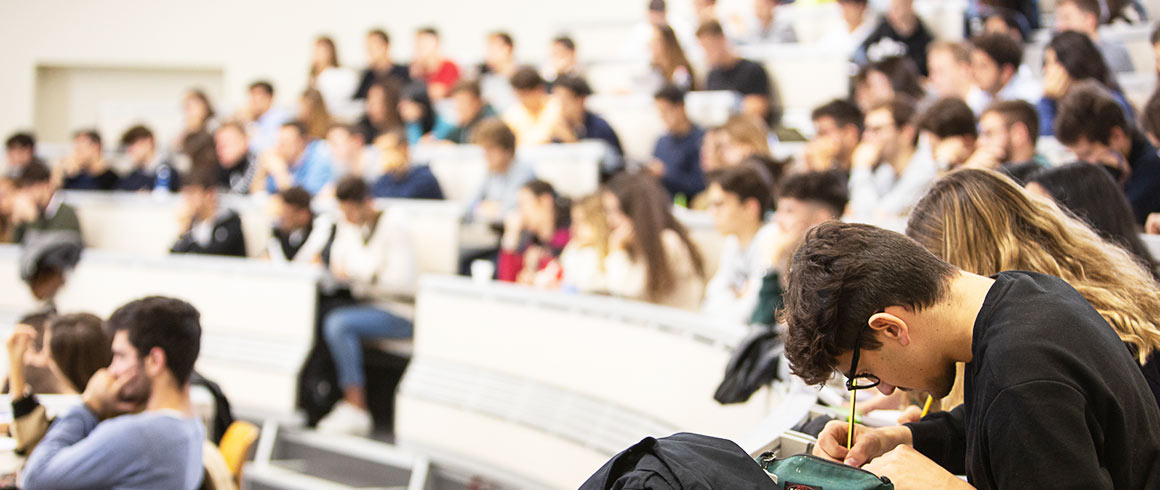Each student, depending on his or her health situation or personal condition, will be able to choose whether to attend classes in presence or remotely throughout the whole period of the course.
The next academic year at Università Cattolica del Sacro Cuore will take place regularly and safely. Students will be able to choose whether to attend classes in presence or remotely. Anyone can return to physically attend lectures at our five campuses in compliance with safety regulations, booking a place within the limits and numbers allowed by social distancing. Those who - for public health reasons, for reasons of personal health, for distance or economic convenience and for the possible rotation of accesses - will opt not to follow the teaching activity in presence will be able to attend lessons while at home throughout the academic year.
Our philosophy for next year
"Everything possible in presence, everything necessary remotely" is, in fact, the philosophy of #eCatt, the plan of our University that offers an integrated teaching method mixing traditional frontal teaching methods - with students and teachers present in the same room - and digital communication, which will allow all students to study from home, without any delays and with full access to all learning opportunities.
#eCatt can help students who will not be able to reach the Campus to be updated with the teaching schedule even if they are far from the University. In order to implement the plan, the University has provided financial resources amounting to €3.5 million, which, in addition to the €1 million in Itially allocated to the Fondo salva studi Agostino Gemelli, includes investments in digital teaching made possible by the technological upgrading of the 500 classrooms at Università Cattolica.
"In a situation still full of uncertainties, Università Cattolica, with the #eCatt project, has structured its activities to enable the full enjoyment of teaching activities both in presence, in compliance with all the health standards required, and remotely, thanks to advanced technological infrastructures", says Antonella Sciarrone Alibrandi, pro-rector of Università Cattolica del Sacro Cuore.
Ensuring a successful model
Since the first day of the suspension of frontal activities (24 February) Università Cattolica has ensured the regular course of study to all members of its faculties. As of 30 May, 1,877 teachers have carried out a total of 37,419 distance learning lectures, with 26,564 recorded video-lectures uploaded to Blackboard, the University's Learning Management System platform; 10,855 live lectures broadcast live with students connected at the same time and carried out through Collaborate Ultra, one of the most innovative tools of Blackboard. A total of 6,775 exam calls were regularly held between 18 March and 23 June, while 360 graduation sessions were held between 11 March and 28 May.
Digitally enhanced teaching: four scenarios
Thus, while waiting to return to live social relationships in presence, to rediscover the value of professors and students meeting to create awareness, knowledge and competence, Università Cattolica will ensure a teaching model that allows all the students enrolled in a degree programme to participate in teaching activities even remotely, with live streamed lessons (the classrooms are equipped with the possibility to broadcast live), video recordings, support teaching material and constant interaction with professors/lecturers.
Remote (but not virtual) didactics, is the result of a strategic alliance of skills between iLab, the e-learning service of Università Cattolica, Cremit, the Centre for Research on Media Education, Innovation and Technology, the Faculties, the Rector's delegate for didactics and the appointed committee of the Academic Senate. The integrated teaching will be designed according to the best scientific standards, which have proved effective in the months of emergency and which the University has further strengthened in view of the next academic year.
Four online teaching scenarios have been defined, which can be combined to create content-rich, integrated and interactive courses.
Dual mode: professors/lecturers are in the classroom with some students in presence and others connected remotely. They can share slides, applications, write on a shared whiteboard and interact with students connected remotely via audio and chat, using a virtual classroom platform. Alternatively, the teacher can use a lecture capture platform, which allows synchronised screen or slide capture and chat contact with remotely connected students. The lesson can be recorded and released on Blackboard.
Online interactive lecture: professors/lecturers have their lesson in a classroom equipped with a PC or at home (remotely) while students follow the lesson. The use of a virtual classroom platform will ensure real-time audio and video communication, the possibility to interact via audio and video with the students, the sharing of content, slides, applications, shared whiteboard. Alternatively, professors/lecturers can use a lecture capture platform, which allows synchronized capture of the screen or slides and contact via chat with the students connected remotely. Lectures can be recorded and released on Blackboard.
Talking head: the teacher records the lesson in advance, from home or at the university, and releases it in his/her Blackboard course to allow students to view and listen to it. The video lesson can contain the teacher's video footage and slides or other teaching material created to support the lesson.
Voice-over presentation: the teacher creates an audio content, slides with audio comment, podcast, and releases the material in his/her Blackboard course so that students can view and listen to it.
Exams and graduation sessions
Exams and graduation sessions, which in many cases have already been held remotely through the Blackboard platform and Microsoft Teams, will take place as indicated in the guidelines released step by step by the University.


